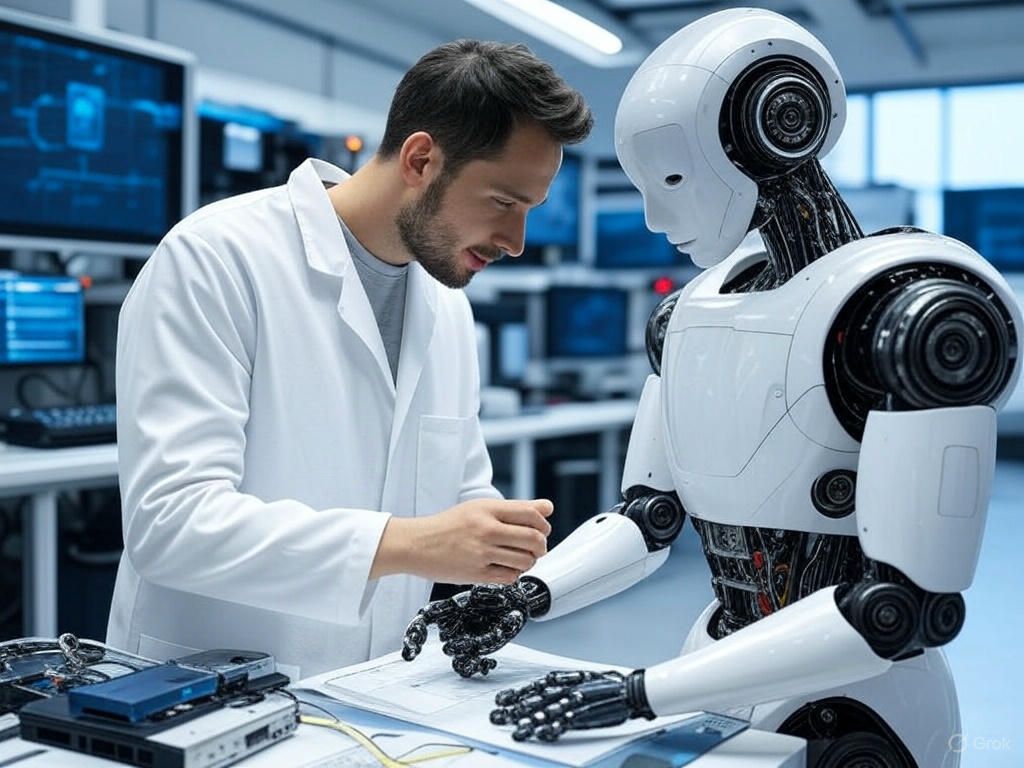Why AI Will Create More Jobs Than It Eliminates: The True Impact of The Technological Revolution

Despite widespread concerns that artificial intelligence will destroy jobs, historical evidence suggests that AI will likely create twice as many jobs as it eliminates. After studying 250 years of technological disruption and analyzing recurring patterns of innovation, we can see that AI follows the same trajectory as previous technological revolutions—initial disruption followed by unprecedented job creation and economic growth.
Understanding Technological Revolutions: The Quantum Leap Waves
Throughout history, technology has evolved in predictable 50-year cycles or "quantum leap waves" that transform economies and societies:
- First Industrial Revolution (1771-1830s): Steam power and mechanized textile production
- Age of Steam and Railways (1829-1873): Transportation revolution and early factory systems
- Age of Steel and Electricity (1875-1908): Mass production begins
- Age of Oil, Automobiles, and Mass Production (1908-1971): Assembly lines and consumer goods
- Age of Information and Telecommunications (1971-2021): Computers and the internet
- Decentralized Tech Revolution (2021-present): AI, blockchain technologies, and more
Each wave initially disrupts certain jobs but ultimately creates far more opportunities than it eliminates.
Why Many Tech Leaders Misunderstand AI's Impact on Employment
Many tech industry leaders have predicted significant job losses due to AI, suggesting that various professions could see 80-90% displacement of workers. These concerns echo fears expressed during previous technological revolutions.
During the Industrial Revolution, the Luddites destroyed machinery they believed threatened their livelihoods. When computers entered the workplace in the 1970s and 80s, people feared mass office worker displacement. When the internet emerged, traditional retail and media jobs were supposedly doomed.
In each case, these fears proved unfounded. The key mistake is looking at technologies in isolation rather than seeing them as part of a larger economic cycle.
Historical Evidence: How Technology Creates Jobs
Let's examine what actually happened during previous technological revolutions:
First Industrial Revolution (1771-1830s)
- Jobs eliminated: Traditional craftspeople, approximately 8% of Britain's population worked in spinning in 1770
- Jobs created: Factory workers, engineers, transportation workers, coal miners, clerks, and managers
- Net result: Manchester, UK grew from 25,000 people in 1771 to over 300,000 by 1851
Age of Steam and Railways (1829-1873)
- Jobs eliminated: Horse-drawn transportation workers, traditional craftsmen, manual laborers
- Jobs created: Railway workers, locomotive manufacturing, telegraph operators, new commercial centers
- Net result: Manufacturing employment in the United States expanded fourfold as railways connected the country
Age of Oil, Automobiles, and Mass Production (1908-1971)
- Jobs eliminated: Buggy makers, craft manufacturing jobs, traditional transportation roles
- Jobs created: Automobile industry, oil production, refining, distribution, mass consumer goods industries, advertising, marketing, retail, suburban construction
Age of Information and Telecommunications (1971-2021)
- Jobs eliminated: Some clerical jobs, data processing roles, manufacturing positions
- Jobs created: Computer-related occupations increased from 450,000 in 1970 to 4.6 million by 2000
- Net result: The personal computer and internet created over 19 million jobs
Five Economic Mechanisms That Drive Job Creation
To understand why technology consistently creates more jobs than it eliminates, we need to consider five key economic mechanisms:
Productivity and Economic Growth: When productivity increases, the economic pie expands, creating more wealth and demand for new goods, services, and workers.
Complementary Effects: New technologies often complement human labor rather than replacing it. AI systems enhance human capabilities, enabling workers to focus on higher-value tasks.
New Industry Creation: Each technological wave spawns entirely new industries that couldn't have been predicted. The automobile industry was unimaginable before the internal combustion engine, yet it employed millions directly and indirectly.
Expanded Consumer Demand: As technologies reduce costs and increase quality, they expand markets and stimulate consumer demand, driving employment growth.
Skill-Based Technological Change: While technology may displace certain routine tasks, it increases demand for skilled workers who can work with new technologies.
AI's Current Impact on Jobs: The Evidence
Contradicting pessimistic predictions, here's what current data tells us:
- According to the World Economic Forum's Future Jobs Report, approximately 170 million new jobs will be created this decade, significantly outpacing the 92 million jobs expected to be displaced.
- Technology-related roles are the fastest-growing jobs by percentage.
- LinkedIn data shows a 59% increase in AI job postings since January 2024.
- The US Bureau of Labor Statistics projects employment of software developers to increase 17.9% between 2023 and 2033, much faster than the average for all occupations.
New Job Categories Emerging from AI
AI is creating entirely new job categories such as:
- AI Prompt Engineers: Specialists who craft queries to elicit optimal responses from AI systems
- AI Ethics Consultants: Professionals ensuring ethical AI implementation
- AI Integration Specialists: Experts implementing AI solutions within business processes
- Machine Learning Engineers: Developers who build and optimize AI models
- AI Trainers: Workers who help AI systems with human feedback
- AI Auditors, Synthetic Media Designers, and AI Strategy Consultants
Five Industries Where AI Will Create the Most Jobs
Healthcare: AI is revolutionizing healthcare, creating jobs in AI-assisted diagnostics, personalized medicine, predictive healthcare, and remote patient monitoring. The healthcare AI market is projected to reach $188 billion by 2030.
Education: While AI may replace some teaching functions, it's creating new educational roles in personalized learning systems, adaptive curriculum development, educational content creation, and AI-enhanced teaching assistance.
Creative Industries: AI is turbocharging content creation, opening opportunities in AI-assisted design, augmented creativity tools, synthetic media production, and content moderation.
Financial Services: AI is transforming finance with roles in algorithmic trading, personalized financial advising, fraud detection systems, and automated compliance monitoring.
Transportation and Logistics: From autonomous vehicle development to supply chain optimization, AI is creating high-paying jobs throughout this sector.
Five Reasons AI Will Create More Jobs Than It Eliminates
General Purpose Technology: Unlike specialized technologies that affect specific sectors, AI is transforming everything from healthcare to entertainment, enabling new business models, products, and services across the entire economy.
Complementary Human Skills: AI automates cognitive tasks in ways that enhance human capabilities rather than replacing them. Skills like creativity, emotional intelligence, ethical judgment, and interpersonal communication remain difficult for AI to replicate.
Massive Global Investment: AI spending grew to over $550 billion in 2024, much of which goes into hiring engineers, developers, project managers, trainers, and compliance specialists.
Unprecedented Productivity Growth: AI-driven productivity gains will expand economic output at unprecedented rates, leading to lower prices, higher wages, and greater consumer spending that drives job creation.
Economic Adaptability: With each previous technological revolution, economies adapted as new job categories emerged and workers developed new skills.
The Most Valuable Skill in the AI Economy
The most invaluable skill in the AI economy will be AI-human interface expertise—the ability to effectively collaborate with, direct, and complement AI systems. This isn't just about technological knowledge but understanding where human judgment, creativity, and emotional intelligence add value that AI cannot replicate.
How to Prepare for the AI Revolution
Develop AI-complementary skills: Focus on creativity, innovation, emotional intelligence, interpersonal communication, critical thinking, complex problem solving, ethical judgment, and AI literacy.
Stay adaptable: Embrace continuous learning by taking online courses, joining communities, and experimenting with new tools.
Look for opportunities in high-growth AI sectors: Healthcare, education, creative industries, financial services, and transportation/logistics.
Consider entrepreneurial opportunities: Look for problems that AI can help solve or ways to implement AI in existing industries.
Position your investments: Consider companies developing AI infrastructure, applications, and complementary technologies.
Conclusion
History shows that technological progress follows a consistent pattern: short-term disruption followed by long-term job creation and prosperity. The AI revolution will likely create more opportunities, wealth, and jobs than any technological shift we've ever seen.
The question isn't whether AI will take your job—it's whether you'll be ready to seize the new opportunities it creates. As Mark Moss, the original creator of this content and the Quantum Leap Waves framework, emphasizes: "The further ahead you can see, the faster you can go." By understanding these historical patterns of technological revolution, we can better prepare for and thrive in the AI-driven future that lies ahead.
